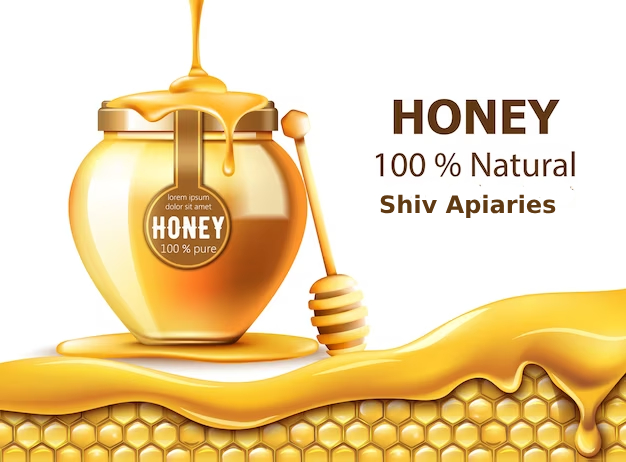
shiv Apiaries
pure natural honey
PURE HONEY EXPORTER
Why shiv Apiaries honey ?
– Welcome to Shiv Apiaries Private Limited, a budding organization nurtured and driven by the vision and dedication of our respected CEO Mr. Virinder Lakra. We started with a small team of workers and only 02 beehives, which have gradually grown to around 3100 as of now. We started as beekeepers in 2000 then started trading from 2007 and then from 2013 we started exporting.
benefits of honey!
Honey offers numerous benefits: natural sweetness, antioxidants, antibacterial properties, soothing for sore throats, wound healing, and promoting digestive health.
- Antioxidant-rich
- Antibacterial properties
- Soothes sore throats
- Aids wound healing
- Promotes digestive health
- Natural sweetener
- Nutrient-rich
- Energy-boosting
- Supports immunity
- Supports immunity
- Skin-nourishing
- Allergy relief
- Balances blood sugar
- Boosts brain health
- Supports weight management
- Rich in vitamins and minerals
- Enhances athletic performance
- Calming and relaxing
- Improves sleep quality
- Helps soothe acid reflux

Raw honey
Raw honey is a pure, unprocessed, and natural form of honey that is directly harvested from beehives. Unlike the commercially processed honey found in most grocery stores, raw honey is not heated, pasteurized, or filtered. It is extracted from the honeycomb and retains all the natural nutrients and enzymes that make it highly beneficial for health.
Unprocessed and Unfiltered: Raw honey is not subjected to high heat or filtration, which preserves its natural goodness. It may contain small particles of honeycomb, pollen, and bee propolis, giving it a cloudy appearance and enhancing its nutritional value.
Rich in Nutrients: Raw honey is a source of essential nutrients such as vitamins, minerals, antioxidants, and enzymes. It contains vitamins B, C, D, and E, as well as minerals like calcium, potassium, magnesium, and iron.
Antioxidant Properties: Raw honey is known for its high antioxidant content, which helps protect the body against harmful free radicals. Antioxidants play a vital role in reducing oxidative stress and lowering the risk of chronic diseases.
Antibacterial and Antimicrobial: Raw honey has natural antibacterial and antimicrobial properties, making it effective in promoting wound healing and fighting infections. It has been used traditionally for its medicinal properties.
Allergy Relief: Some people believe that consuming local raw honey can help alleviate seasonal allergies. The theory is that consuming small amounts of local pollen through raw honey can desensitize the body to allergens over time.

sage honey
Sage honey is a type of honey produced by bees that collect nectar primarily from sage plants (Salvia spp.). Sage is a herbaceous plant belonging to the mint family, and it comes in various species and varieties, each with distinct flavors and aromas.
Flavor: Sage honey has a unique taste that varies based on the species of sage and the geographic region where it is produced. It is often described as mildly sweet with herbaceous and earthy undertones. Some varieties may have hints of mint or eucalyptus notes.
Color: The color of sage honey can range from light amber to a darker, golden brown, depending on the specific plants the bees harvested nectar from.
Texture: Like other types of raw honey, sage honey tends to have a thick and creamy texture, making it easy to spread on various foods.
Aroma:The aroma of sage honey is usually pleasant and may carry some of the herbal scents of the sage plants..

honey blend
Honey blend, also known as mixed honey or blended honey, is a product created by combining different types of honey to achieve a specific taste, color, and texture. Beekeepers and honey producers often blend various varieties of honey together to create a unique flavor profile that appeals to consumers.
Flavor Enhancement: Different types of honey, such as clover honey, wildflower honey, orange blossom honey, and more, have distinct flavor profiles. By blending these varieties, producers can create a well-balanced and more complex flavor that appeals to a wider range of tastes.
Consistency: Honey obtained from single floral sources can vary in taste and color from batch to batch due to factors such as weather conditions and plant variations. Blending honey helps maintain a consistent taste and appearance for consumers who prefer uniformity.
Bulk Production: Honey blending allows producers to manage the supply and meet the demand by combining various types of honey in larger quantities.
Cost Control: Some types of honey may be more expensive or less available than others. Blending can be a cost-effective way to create a product with desirable characteristics at a reasonable price point.





© 2023 Shiv-Apiaries. All Rights Reserved











